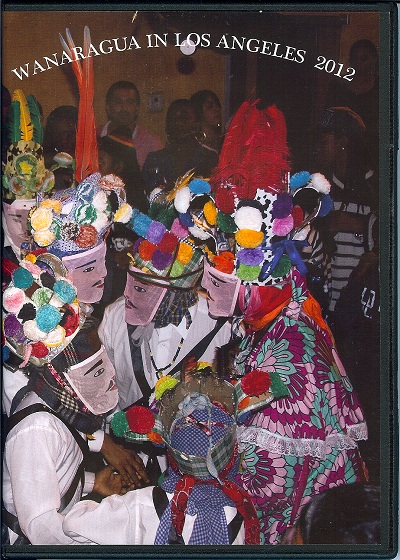 Flavio “Paps” Alvarez, to the different neighborhoods and homes of Garifuna in Los Angeles as they present the traditional expression of Wanaragua on Christmas and New Year’s Day.
Flavio “Paps” Alvarez, to the different neighborhoods and homes of Garifuna in Los Angeles as they present the traditional expression of Wanaragua on Christmas and New Year’s Day.
The Wanaragua is a celebration that commemorates a resistance to British colonization on the island of San Vicente, where the Garifuna community emerged from Carib, Arawak, and Western African Diasporas. Through oral histories, it is understood that the Garifuna men fighting against the colonials strategically masqueraded utilizing women’s clothing while the British troops infiltrated the villages. Not recognizing a male presence within the villages, the British dropped their guard leaving them vulnerable to the attacks of these men dressed as women. Today the act of masquerading is heightened not only in the usage of women dresses, but also in the use of masks that each dancer wears. A crown with feathers, flowers, and ribbons further enhances the regalia of the Wanaragua dancer. The outfit is then completed with a series of shells with seeds tied to the shin of the dancers that have a rattle effect. Other dancers are dressed in a simple male costume of black shin high pants and a white shirt that is adorned with sashes that cross at the chest and wrap around the waist. The male costume also utilizes a mask, crown and ribbons. Today, with the reach of globalization, Nike, Addidas, Pumas, or Reebok tennis shoes are the choice footwear of dancers in Los Angeles and Central America. The use of tennis shoes makes much sense since the performances most often occur on cement driveways or asphalt parking lots of apartment buildings.
 ACTA’s Apprenticeship Program, master Flavio Alvarez is mentoring apprentice Taija Rae “Tye Tye” Garcia, the first women in her family to dance Wanaragua and a leading member in Alvarez’ ensemble that has been together since 1998.
ACTA’s Apprenticeship Program, master Flavio Alvarez is mentoring apprentice Taija Rae “Tye Tye” Garcia, the first women in her family to dance Wanaragua and a leading member in Alvarez’ ensemble that has been together since 1998.
The video begins with Chief Flavio Alvarez narrating in Garifuna the history of Wanaragua in Los Angeles while the dancers prepare and get dressed for the daylong endeavor. The opening statement ultimately references the Diaspora, letting people in Honduras, Guatemala, and Belize know that the people of in Los Angeles have Wanaragua. Then the journey begins:
The video literally follows the dancers as they travel from home to home throughout the Southern Los Angeles city. At each home three drummers set up—similar to other Afro-Caribbean and Latin America forms, this form uses a three drums in which two establish the rhythmic pulse in a coordinated pattern that mixes low and middle ranges, while a lead drum (primera) develops both a competition and dialogue with a single dancer that solos. Behind the sitting drummers, singers stand performing choruses, establishing a swinging answer and call practice—a form that traces back to Western African traditions. Once the music is set in a groove, dancers take turns, first by greeting the drummers, singers, those that are present, and those that are remembered, then they begin to express themselves through fast pulsating bounce movements, making the shells on their shins rattle in tempo with the drummers.
